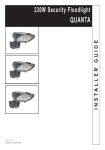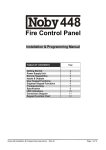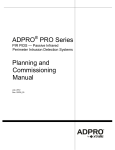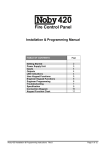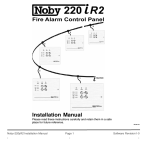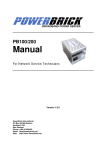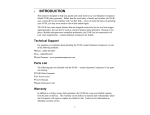Download Noby-65 Installation Manual Rev.1
Transcript
65 Intruder - Fire - Water Combined Alarm Installation Manual and User Operating Instructions TABLE OF CONTENTS First Power-Up Power Supply Unit Input & Detection Circuits Output & Alarm Circuits Keyswitch Options Remote Signalling Equipment Technical Specification Connection Diagrams User Operating Instructions Page 2 3 3 5 6 6 7 8 -10 11 -12 For your safety: This equipment is to be installed, serviced and maintained by a suitably qualified technical person with the requisite knowledge of electrical and fire safety installations. The Noby-65 is intended to be permanently connected to the 230VAC house wiring via a 2A fused spur and in accordance with local wiring regulations. Part of the internal circuitry operates at 230VAC and presents an electrical shock hazard. Do not attempt to open, dismantle, repair or tamper with this equipment without first disconnecting the 230VAC supply voltage. This is Class-1 electrical equipment and must be earthed. Please read this Installation Manual carefully and retain for future reference. Noby-65 Installation Manual & Operating Instructions (Rev.1) Page 1 of 12 FIRST POWER-UP We strongly recommend that the Noby-65 is first powered up with all 10K End Of Line resistors fitted at the panel, as supplied by the factory. In this way you can gain confidence that the panel is operating correctly before introducing detector and sounder circuits. Power-Up With Battery • Turn the Keyswitch to the OFF position. • Connect the black battery lead to the battery –‘ve terminal. • Connect the red battery lead to the battery +’ve terminal. It is normal to see a small spark. • 60s Start-up Period: i) All LEDs flash for 60s *. ii) The Buzzer output will make a pulsing sound (if connected). After Start-up: i) The green Power LED flashes. ii) The yellow Fault/Alarm LED is lit. iii) The red Sabotage LED is lit (because Noby-65 lid is removed). * The 60s Start-up Period can be prematurely terminated by turning the Keyswitch to FULL for 4s, and then back to OFF. • Perform a System Reset: Momentarily turn the Keyswitch to FULL and then to OFF within 2s. Observe a 2s LED test. • After System Reset: i) The green Power LED is off (because the 230VAC is absent). ii) The yellow Fault/Alarm LED is lit. iii) The red Sabotage LED is lit (because Noby-65 lid is removed). • Connect 230VAC supply to the 230v/50Hz AC screw terminal block. • Replace the Noby-65 panel lid: observe the yellow Fault/Alarm LED turn off. • Switch on the 230VAC power and observe the green Power LED flash (indicating 230VAC restored). • Perform a System Reset: momentarily turn the Keyswitch to FULL and then to OFF within 2s. Observe a 2s LED test. • The panel should now be in a quiescent standby state with only the green Power LED lit. Power-Up With 230VAC • Turn the Keyswitch to the OFF position. • Connect a 230VAC power supply to the 230v/50Hz AC screw terminal block, and switch on. • 60s Start-up Period: i) All LEDs flash for 60s *. ii) The Buzzer output will make a pulsing sound (if connected). After Start-up: i) The green Power LED will flash. ii) The yellow Fault/Alarm LED will be lit. iii) The red Sabotage LED is lit (because Noby-65 lid is removed). * The 60s Start-up Period can be prematurely terminated by turning the Keyswitch to FULL for 4s, and then back to OFF. • Perform a System Reset: Momentarily turn the Keyswitch to FULL and then to OFF within 2s. Observe a 2 second LED test. • After System Reset: i) The green Power LED is lit (230VAC OK indication). ii) The yellow Fault/Alarm LED is lit. iii) The red Sabotage LED is lit (because Noby-65 lid is removed). • Connect the black battery lead to the battery –‘ve terminal. • Connect the red battery lead to the battery +’ve terminal. It is normal to see a small spark. • Replace the Noby-65 panel lid: observe the yellow Fault/Alarm LED turn off. • Perform a System Reset: momentarily turn the Keyswitch to FULL and then to OFF within 2s. Observe a 2s LED test. • The panel should now be in a quiescent standby state with only the green Power LED lit. IMPORTANT: TAKE CARE TO CONNECT THE BATTERY CORRECTLY. Whilst there is a measure of protection against accidental reverse connection of the battery, such action will almost certainly blow fuse F3, and may cause permanent damage to the Noby-65 panel. Such damage is identifiable to Noby UK Ltd. and is not covered by the warranty. Noby-65 Installation Manual & Operating Instructions (Rev.1) Page 2 of 12 POWER SUPPLY UNIT The PSU provides a regulated voltage rail of 13.6v (nominal 12v), with a continuous current rating of 1.5A, and a 20-minute rating of 2.0A. The PSU is designed to meet the internal standby power requirements of the Noby-65 and also to charge and maintain the 7Ah SLA battery in optimum condition. The battery standby time is dependant upon the overall system current drawn, including all connected equipment. Also it is strongly recommended that the continuous system standby current does not exceed 1.0A, because some reserve PSU capacity must be available to recharge the battery following an alarm condition or a prolonged period of 230VAC power loss. The Noby-65 enclosure can accommodate one 12v/7Ah SLA battery. The PSU is monitored for loss of 230VAC power, low battery voltage, and a Battery-Condition load test is performed every 12hrs. PSU faults are indicated by a flashing Power LED and the Fault LED, together with an audible pulsing fault tone at the Buzzer output. Always ensure that the maximum current drawn in alarm does not exceed the 3.0A battery fuse limit (F3). The PSU is monitored for: i) PSU Fault 230VAC Absent or Fuse F2 blown: LED Status Power LED is off. (after a 10s delay). ii) 230VAC Restored: Power LED flashes. (memory). iii) Low Battery Voltage: Power LED flashes. Fault LED is lit when the voltage <10.0v iv) Battery-Condition or Fuse F3 blown: Power LED flashes Fault LED is lit. INPUT & DETECTION CIRCUITS Figure 2 shows the detector wiring diagram for a typical residential alarm system. Detection Circuit Terminal No. Description Intruder Zone-1 A13 & A14 Intruder alarm circuit. PIRs and contacts. Intruder Zone-2 A15 & A16 Intruder Exit / Entry A11 & A12 Duress / Panic Circuit A09 & A10 24hr circuit. Fire Detectors A03 & A04 24hr circuit. 24v optical & ionisation smoke, or rate-of-rise heat detctors. Water Detectors A05 & A06 24hr circuit. Water float switches. Sabotage Circuit (Anti-Tamper) A07 & A08 24hr circuit. This circuit Includes the Noby-65 lid microswitch. Intruder alarm circuit. PIRs and contacts. Zone-2 Isolated when Part-Set. Delayed intruder alarm circuit for the Entry/Exit route. Entry timer adjustable 0 – 120s. Exit timer adjustable 0 – 120s. PIRs and contacts. End Of Line Resistors The Noby-65 requires that all detection circuits be terminated with a 10K End Of Line resistor, to facilitate opencircuit fault monitoring. For maximum security the EOL resistors should be connected at the last detection device at the end of each cable run, and for this reason it is advised to ‘daisy-chain’ the cable, with no ‘T’ junctions. Only one EOL resistor is permitted on each circuit, such that in steady-state condition the Noby-65 sees a circuit resistance of 10kohm. Any detection circuit not being used must have its EOL resistor connected at the Noby-65 terminals. Auxillary 12v Detector Supply [A01,A02] A 12V supply fused at F500mA (F2) is provided at terminals A01 & A02 to supply power for PIRs and other low power electronic detection devices. Noby-65 Installation Manual & Operating Instructions (Rev.1) Page 3 of 12 Intruder Detection Circuits [A11,A16] There are three intruder circuits: Zone-1, Zone-2 and Exit/Entry. Each detection circuit may comprise any combination of: i) door or window magnetic contacts. ii) electronic detectors - PIR, ultrasonic or doppler-microwave. iii) window foil. iv) vibration or glass-break detectors. v) pressure mats. Zone-1 is the main intruder detection circuit, and is armed when the keyswitch is turned to FULL or PART. Zone-2 is the secondary intruder detection circuit, and is armed only when the keyswitch is turned to FULL. Zone2 is normally used to protect the night-time living area in a house, such that the occupants can freely move around without causing an alarm, whilst the rest of the house is protected in Zone-1. Exit/Entry is the area covering the direct path between the Noby-65 and the final exit door. This circuit allows the keyholder to safely leave the property within a preset Exit-Time. On re-entering the premises the Entry-Tone will start, and the keyholder must proceed directly to the Noby-65 panel and turn the keyswitch to OFF. Straying off the Exit/Entry route into an area protected by Zone-1 or Zone-2 will trigger an immediate alarm condition. Electronic detection devices (e.g. PIRs) are powered from the Auxillary 12v supply terminals (A01 & A02), fused at 500mA (F2). Warning: do not to overload this 12v supply. As a rough guide each PIR draws 25mA. The latching LED function of PIRs can be controlled by connecting the appropriate PIR terminal (often called SW+, Set, C or Control) to the SW+ signal appearing at terminal B13. This signal is normally 0v and switches to 12v when the Noby-65 is fully armed i.e. after the Exit-Time period. This SW+ signal can also be used to signal a System-Set (Open/Closed) signal for Remote Signalling Equipment. Pressure Mats must be connected between the two cores of the detection circuit, such that the EOL resistor becomes short-circuit in alarm. The cable for each circuit may require up to 7 cores: 2 cores for the alarm detection circuit, 2 cores for the detector supply, 1 core for the SW+ signal, and 2 cores for the Sabotage circuit (Anti-Tamper). Any spare cores should be used to ‘stiffen’ the detector 0v power connection. Duress / Panic (Personal Attack) [A09,A10] Activating the Duress / Panic Circuit will trigger a silent Duress response at signal output B12. A silent Duress alarm is sometimes the preferred option for systems employing Remote Signalling Equipment. For personal safety reasons Duress is the default mode of operation, as supplied from the factory. Alternatively, the Noby-65 can be configured to give a full local audibles Panic alarm: To configure the Panic Option: i) remove all power from the Noby-65 – both battery and 230VAC power supply. ii) press the Panic Button such that the Panic Circuit is open-circuit. iii) reconnect the power supply to the Noby-65. iv) reset the Panic Button. v) reset the Noby-65 by performing a System Reset. Important: the Panic option will revert back to Duress in the event of total power loss to the Noby-65. Sabotage Circuit (Anti-Tamper) [A07,A08] The Sabotage circuit protects the Noby-65 from criminal interference or accidental damage. This is a single circuit and should be routed around all the intruder detection circuits, and through all lid switches. The Noby-65 is supplied with an internal lid microswitch pre-wired and fitted with a series 10Kohm EOL resistor at terminal A08. To insert new sabotage loops: First unscrew the wire at terminal A07, and then connect any newly created loops between A07 and the free end of the microswitch wire. For typical installations it is recommended to leave the EOL resistor in its original position at terminal A08. Fire Detection Circuit [A03,A04] The Noby-65 incorporates a low power 12v/24v invertor which permits the use of industry standard 24v conventional smoke detectors. Any combination of conventional optical or ionisation smoke detectors, or rate-ofrise heat detectors can be connected. The total steady-state current taken from the Fire Detector terminals A03 & A04 must not exceed 1mA. Typically this equates to a maximum of 10 detectors, assuming a rated current of 100uA per detector. The Fire Detector Circuit is monitored for open-circuit faults. Water Alarm Detection Circuit [A05,A06] This circuit is intended to accomodate water level float switches for use in flood detection. Once triggered the Water Alarm Output can be used to shut off a water solenoid operated valve as shown in Figure 3. Although this circuit is labelled ‘Water’, it can be used for other purposes e.g. a 24hr freezer alarm to give a warning of rising freezer temperature. Noby-65 Installation Manual & Operating Instructions (Rev.1) Page 4 of 12 OUTPUT & ALARM CIRCUITS Figure 3 shows the alarm outputs wiring diagram for a typical residential alarm system. Intruder Alarm Relay Output [B01,B02,B03,B04] The Noby-65 alarm siren output is provided at terminals B01 to B04. Terminal B01 is 0v, and terminals B02, B03 and B04 are a set of make/break relay contacts. For most installations a Siren will be driven from this relay, and for convenience the centre contact is connected to 12v via fuse F5 on the PCB. This 12v feed can be diconnected by removing fuse F5 – leaving a clean set of voltage-free contacts rated at 30V/2.5A. This alarm output relay is activated for a preset Siren-Time, adjustable from 10s to 360s (P3). It is recommended to use polarised sirens or bells fitted with a suppressor. Fire Alarm Ouput [B05,B06,B07] The following two fire sounder outputs are fused at F1A (Fuse F4): i) the 24hr terminal (B05) gives a fire alarm at all times, even when the keyswitch is OFF. ii) the 12hr (or SET) terminal (B07) activates only when the keyswitch is turned to FULL or PART. Both terminals are open-collector pnp transistor outputs and switch to +12v during a fire alarm condition. It is recommended to use polarised sirens or bells fitted with a suppressor. Water Alarm Output [B08,B09] Terminal B08 is a 12v supply fused at F1A, sharing a common fuse (F6) together with the Buzzer Output. Terminal B09 is an open-collector npn transistor output, switching from 12v to 0v on detection of a Water Alarm condition. This output is suitable for driving a siren, bell or sounders. Alternatively, it is possible to activate a Solenoid Water Valve to disconnect the water supply. Note that in most cases a 230VAC isolating relay is required to operate the Solenoid Valve. It is recommended to fit a suppressor diode across the relay coil to prevent damage due to high voltage transients, as shown in Figure 3. Some relays are supplied with a suppressor fitted internally. IMPORTANT: DO NOT CONNECT 230VAC DIRECTLY TO THE NOBY-65 TERMINALS. Internal Warning Buzzer Output [B10, B11] This output is provided at terminals B10 & B11 for audible indication of warning and fault conditions. Terminal B10 is a 12v supply fused at F1A, sharing a common fuse (F6) together with the Water Alarm Output. Terminal B11 is an open-collector npn transistor output, switching from 12v to 0v. The Noby-65 emits the following Buzzer tones: i) Exit Time: Continous steady tone. ii) Entry Time: Slow pulsing tone (1Hz) iii) Alarm & Faults: Fast pulsing tone (2Hz) It is recommended that the Internal Warning Buzzer (or piezo sounder) can be heard outside the Final Exit Door, so that the keyholder can hear the Exit-Time finish and be confident that the Noby-65 is fully armed. Following an alarm condition the Buzzer will continue to sound until the keyswitch is turned to OFF. Duress / Panic Signal [B12] A positive going 12V/10mA signal output (B12), which latches on receipt of a Duress or Panic alarm condition. This output is cleared by performing a System Reset. This signal is provided to trigger Remote Signalling Equipment. PIR Memory SW+ Signal [B13] A positive going 12V/10mA signal output B13, switching to 12V when the Noby-65 is either Full-Set or Part-Set. This signal can be used to control the latching LED function of PIR detectors connected to Zone-1 or Zone-2. To reset a latched PIR detector: i) turn the Keyswitch to FULL. ii) allow the Exit-Time to finish. iii) turn the Keyswitch to OFF. The SW+ signal can also trigger Remote Signalling Equipment to transmit an Open/Close signal to a central monitoring station. Note: Some PIR detectors require a 10K pull-down resistor to be connected from terminal B13 to 0V. Noby-65 Installation Manual & Operating Instructions (Rev.1) Page 5 of 12 KEYSWITCH OPTIONS Internal Keyswitch The Noby-65 has an internal positions: i) OFF: ii) FULL-SET: iii) PART-SET: keyswitch fitted as standard, supplied with 4 keys. The switch has the following All Intruder circuits are disarmed. Other 24-hour circuits remain active. All Intruder circuits are armed. Noby-65 is Full-Set after the Exit Time. Noby-65 is Part-Set after the Exit Time, with Zone-2 isolated. External Keyswitch Connections [B14,B15,B16,B17] The Noby-65 can be operated remotely by connecting an external keyswitch to terminals B15-B17 as shown in Figure 3. Note that switching terminal B15 to 0v causes the Noby-65 to Full-Set, whilst switching terminal B17 to 0v causes the Noby-65 to Part-Set. Terminal B16 is the 0v connection. Terminals B14 and B15 must be linked together for correct operation of the internal keyswitch. An attractive alternative to a mechanical keyswitch is the Nobycode NC-02 Remote Keypad (Figure 4). The NC02 is specifically designed to control the Full-Set, Part-Set and System Reset functions of the Noby-65. The NC-02 keypad also has 2 LEDs to remotely indicate the ON/OFF status and the Alarm/Fault status of the Noby-65. For additional security it is recommended to remove the two EOL resistors from the Noby-65 terminals and reconnect them in the remote keyswitch housing, such that any break in the cable will force the Noby-65 to either Full-Set or Part-Set the intruder system. For high security installations it is also recommended to route the Sabotage circuit though the cable and connect through any lid microswitches. REMOTE SIGNALLING EQUIPMENT (AUTO-DIALLER) Power Part 0V External Keyswitch Connection Full SW+ Panic Water 12V Buzzer 12V 0V 12hr 03 04 05 06 07 08 09 10 11 12 13 14 15 16 17 24hr Fire C NC 01 0v B 12v 65 0V Intruder NO Siren The Noby-65 cabinet can accomodate an Auto-Dialler underneath the main circuit board assembly. Figure 1 shows a typical Auto-Dialler connection diagram. The channel numbers may differ according to the signal priorities demanded by the remote central station. Also take care to ensure that the Water Alarm channel is programmed to be a negative going input signal. B 1 2 3 4 5 6 7 8 Alarm Channels Remote Signalling Equipment (Auto-Dialler) Figure 1: Auto Dialler Connections Noby-65 Installation Manual & Operating Instructions (Rev.1) Page 6 of 12 TECHNICAL SPECIFICATION Power Supply Unit Value Unit 230 +10% -6% volts AC 50 / 60 Hz Mains Power Rating 30 VA Nominal Battery Voltage 12 volts 13.6 volts Mains Supply Voltage Mains Supply Frequency Regulated PSU charger voltage Comments Regulated PSU charger current: • 20 minute rating • continuous rating Fused Outputs: F1 30VAC Transformer Secondary F2 Auxillary 12v Supply F3 Battery +’ve F4 Fire Alarm Outputs F5 Intruder Alarm Output F6 Water Alarm & Internal Buzzer 2.0 1.5 A A 2.0 500 3.0 1.0 1.0 1.0 A mA A A A A T2A F500mA T3A F1A F1A F1A Standby Battery Current 70 mA 9 EOL resistors fitted Low Voltage Monitor 10.0 volts Battery Condition Test Yes Detection Circuits Value No. Detection Circuits: 7 End Of Line (EOL) Resistor Open Circuit Monitoring No. Detectors Per Fire Zone Fire Circuit Detection Threshold Alarm Output Circuits Intruder Alarm Output 20mm Quick Blow 20mm Quick Blow 20mm Quick Blow 20mm Quick Blow 20mm Quick Blow 20mm Quick Blow 10s load test every 12hrs Unit Comments Zone-1, Zone-2, Exit/Entry, Duress/Panic, Fire, Water, Sabotage (Anti-Tamper). 10,000 ohms R > 17,000 ohms 10 based on 100uA per detector R< 3000 ohms Value Unit SPDT Relay Comments 12v centre contact, fuse F5 24Hr Fire Alarm Output 0 –> 12 volts open-collector pnp transistor, fuse F4 12Hr Fire Alarm Output Water Alarm Output 0 –> 12 volts open-collector pnp transistor, fuse F4 12 –> 0 volts open-collector npn transistor, fuse F6 Internal Buzzer Output 12 –> 0 volts open-collector npn transistor, fuse F6 Signal Outputs Value Unit Comments 10 10 mA mA 0v --> 12volt, +’ve going signal 0v --> 12volt, +’ve going signal Value Unit Comments 368 x 275 x 75 mm 1.2mm powder coated steel 4.5 Kg Duress / Panic Signal SW+ Signal (panel SET signal) Cabinet Dimensions (width x height x depth) Shipping Weight: Noby-65 Installation Manual & Operating Instructions (Rev.1) Page 7 of 12 Exit / Entry Zone-1 PIR Zone-2 PIR PIR PIR Door / Window 0v 12v SW+ EOL SAB ALM ALM EOL EOL EOL SAB 0v 12v SW+ SAB ALM 0v 12v SW+ SAB 0v 12v SW+ ALM Door / Window EOL Sab. Window Foil Alm Final Exit Door Panic Sab. Water Detectors EOL EOL Fire / Smoke Detectors 03 04 P1 P2 0v 12v Smoke 0v Detector Circuit 24v Exit Timer Entry Timer 0-60s 0-60s 10-360s Figure 2: A Noby-65 Lid Switch 0V Part External Keyswitch Connection Full SW+ Panic Water 12V Buzzer 12V 12hr 03 04 05 06 07 08 09 10 11 12 13 14 15 16 17 24hr Fire 01 0V B Siren 0v + 0v + 0v + 0v + 0v + 0v + Timer Water Sab. Panic Exit/ Zone Zone Entry 1 2 C NC 65 P3 0V Intruder NO Siren Aux.12v A 05 06 07 08 09 10 11 12 13 14 15 16 01 B Detection Circuits Wiring Diagram Noby-65 Installation Manual & Operating Instructions (Rev.1) Page 8 of 12 Intruder Siren - + - 0V Part SW+ Full B External Keyswitch + OFF Part 12v Fire Sounder - External Keyswitch Connection Internal Piezo Buzzer + Suppressor Diode Panic 12hr 12V 0V Water 03 04 05 06 07 08 09 10 11 12 13 14 15 16 17 12V Buzzer 01 24hr Fire 12v C NC B 0V Intruder NO Siren 65 - Full Suppressor Diode e.g. 1N4001 EOL EOL Isolation Relay + 230VAC Contacts Intruder Bell 230VAC Power Figure 3: Alarm Outputs Wiring Diagram & External Keyswitch Solenoid / Motorised Water Valve Figure 4: NobyCode NC-02 Connection L1 L2 LEDS 12v 0v L1 0V Part External Keyswitch Connection Full SW+ Duress 12V Buzzer 65 10 11 12 13 14 15 16 17 L2 1 2 3 4 5 6 7 8 9 * 0 # Rly1 Sab Rly2 B Link EOL EOL NOBYCODE NC-02 Noby-65 Installation Manual & Operating Instructions (Rev.1) Page 9 of 12 End Of Line Resistors (10K) P2 Exit Timer Entry Timer 0-60s 0-60s 10-360s Siren 0v + 0v + 0v + 0v + 0v + 0v + Timer Water Sab. Panic Exit/ Zone Zone Entry 1 2 Black OFF Panic PART SET + - 12v / 7Ahr Sealed Lead Acid Battery 0V Part External Keyswitch Connection Full SW+ Panic Water 12V Buzzer 12hr 03 04 05 06 07 08 09 10 11 12 13 14 15 16 17 24hr Fire 01 0V B FULL SET C NC Water Zone-2 0V Intruder NO Siren Fault / Alarm F6 F1A Fire Red A Zone-1 Power F5 F1A + 13.6v F4 F1A 0v F3 T3A 65 - 05 06 07 08 09 10 11 12 13 14 15 16 P3 P1 12V A 30VAC 03 04 01 0v 12v Smoke 0v Detector Circuit 24v F2 F500mA Aux.12v F1 T2A B End Of Line Resistors (10K) Figure 5: Noby-65 PCB Assembly INSTALLATION NOTES Noby-65 Installation Manual & Operating Instructions (Rev.1) Page 10 of 12 USER OPERATING INSTRUCTIONS Exit Procedure: Full-Set: • Check that only the green Power LED is lit. • Turn the Keyswitch to FULL-SET. • All LEDs illuminate for 2 seconds, followed by a continuous Exit Tone. • Proceed directly to the Final Exit Door. Do not stray off the Exit Route. • Leave the premises and listen for the Exit Tone to stop. Part-Set: • Check that only the green Power LED is lit. • Turn the Keyswitch to PART-SET. Zone-2 is isolated and the Zone-2 LED will flash slowly. • All LEDs illuminate for 2 seconds, followed by a continuous Exit Tone. • Proceed directly through the Exit Route to the night-time living area (Zone-2). • Listen for the Exit Tone to stop. Note: All existing alarm conditions must be clear before attempting to arm the intruder system. The Noby-65 will abort the Exit procedure in the event of a system fault or alarm, and the buzzer will emit a rapid pulsing tone. Perform a System Reset to clear the LEDs and try again. Entry Procedure: • Open the Final Exit Door. A slow pulsing Entry Tone will commence. • Proceed immediately to the Noby-65 control panel. Do not stray from the Entry Route • Turn the Keyswitch to OFF. The Entry Tone will stop. Following an Intruder Alarm: • Turn the Keyswitch to OFF. The Siren and Internal Buzzer will silence. • Observe and note the red LEDs. • Perform a System Reset. To clear latched PIR LED indications: • Turn the Keyswitch to FULL. • Allow the Exit Time to finish. • Turn the Keyswitch to OFF. System Reset: • Momentarily turn the Keyswitch to FULL and then to OFF within 2s. • Observe a 2s LED test. Note: If the cause of an alarm still persists then the alarm will re-trigger immediately following a System Reset. To Silence the Alarm: • Turn the Keyswitch to FULL for 4 seconds. • Turn the Keyswitch to OFF. Following a Fire Alarm or Water Alarm: • CARRY OUT THE PRESCRIBED EMERGENCY PROCEDURE Only when it is safe to continue: • Silence the alarm. • Observe and note the red LEDs, which will identify the cause of the alarm. • Perform a System Reset. Cleaning: Clean external surfaces with a damp cloth and mild detergent. Do not use abrasives, solvents or polish. Noby-65 Installation Manual & Operating Instructions (Rev.1) Page 11 of 12 LED Indications Continuous Power 230VAC OK. PSU or Battery Fault 230VAC restored. Fault / Alarm Alarm or System Fault N/A N/A Fire Alarm First To Alarm or Fault N/A Water Alarm First To Alarm or Fault N/A Panic Alarm First To Alarm N/A Sabotage / Tamper Alarm First To Alarm N/A Exit / Entry Alarm First To Alarm N/A Zone-1 Alarm First To Alarm N/A Zone-2 Alarm First To Alarm Zone-2 Isolated (Part-Set) 2 Flashes / sec 1 Flash / sec Norwegian 65 SONE 1 SONE 2 AV DRIFT BRANN RAN DEL FEIL / ALARM PÅ(2) VANN English 65 EXIT / ENTRY ZONE-1 ZONE-2 OFF POWER FAULT / ALARM FIRE PANIC WATER Noby-65 Installation Manual & Operating Instructions (Rev.1) PART SET FULL SET Page 12 of 12












